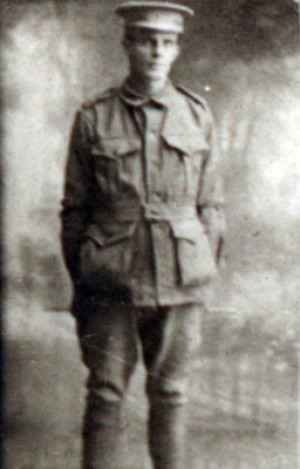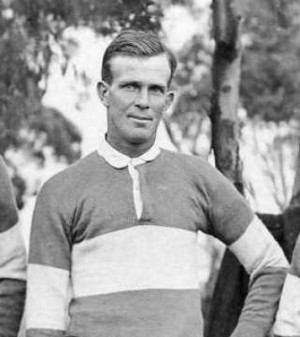Service Details
- Branch of Service
- Army
- Conflict
- World War I (1914-1918)
- Date of Enlistment
- 29/10/1915
- Place of Enlistment
- Goulburn NSW
Personal Details
- Gender
- Male
- Other Name(s)
- Nicknamed 'Mack'
- Date of Birth
- 15/06/1888
- Place of Birth
- Sutton NSW
- Address (at enlistment)
- 'Fern Hill', Yass Road, Ainslie ACT
- Occupation
- Forester at Mount Stromlo ACT
- Next of Kin
- Son of George and Anne Southwell of 'Fern Hill', Ainslie. Brother of Frederick Silas Southwell, Canberra via Queanbeyan.
- Burial Place
France 744 AIF Burial Ground Grass Lane, Flers
Unit and Rank Details
- Service Number
- 4524
- Final Rank
- Private
- Final Unit
- 20 Battalion AIF
Fate
Died (killed in action) at Guedecourt near Flers, France, 5 November 1916 aged 28 years
Commemoration
AWM Roll of Honour Memorial Panel 92, Canberra ACT
Large stone tablet on outside of northern wall of St. John's Church, Reid ACT
World War 1 Memorial, corner of Lowe St and Farrer Place, Queanbeyan NSW
Queanbeyan RSL Wall of Remembrance, Crawford St, Queanbeyan NSW
Queanbeyan Methodist Church Roll of Honour
Hall Memorial Grove, Victoria Street, Hall ACT
Warrior Chapel, St. Andrew's Presbyterian Church, Forrest
Memorial Window, St. Ninian's Uniting Church, Brigalow Street, Lyneham
Ainslie Cricket Club Honour Roll - refer Queanbeyan Age 28 January 1916
Notes
Southwell was born at the family property 'Rosevale' near Sutton in 1888 but his family lived at 'Coolamine' on the western side of the Brindabellas where his father George worked as overseer for Frederick Campbell from 1882 to 1907. The family moved to 'Fern Hill', Upper Canberra in 1911. Southwell was working for Thomas Weston and the Afforestation Branch of the Department of Home Affairs planting pine trees on the slopes of Mt. Stromlo when he enlisted in October 1915 in Goulburn.
He embarked from Sydney as a Private with the 11th reinforcements to the 20th Battalion in April 1916 and in October wrote to his uncle about the trip to England, where he arrived in June, and his impressions of the 'Old Country'.
"It was a lovely sight after the sea trip and sands of Egypt as the surrounding hills were covered with greenery, ornamental trees and shrubs, also nicely kept hedges. The green hills of England we enjoyed very much, and everywhere seemed a picture being so neat and well-cared for, but the majority of buildings were of a very old class and quite a number had thatched roofs. There was grass everywhere and stock of all descriptions in good condition. At the first place our train stopped we were met by the Mayoress and Committee and served with tea and cakes, which were very welcome. At the next stopping place we left the train and with all our belongings on our shoulders had to march about a mile to our camp. Was very pleased to see we had huts to live in, the accommodation turned out very good. We had straw mattresses to sleep on and four blankets and every one was needed as the nights are cold and days also with every day a shower of rain. After being settled a fortnight we were granted four days leave and went to London and spent a very enjoyable holiday, seeing some nice sights including the Tower of London - a most interesting place containing numerous jewels and war material of ancient ages. We had a lovely view from the top of the Tower and Tower Bridge also the place where various kings and queens of England were put to death. Westminster Abbey is another beautiful place and we were shown everything of interest to be seen there, as we went through with a party of wounded soldiers who were being shown over. St Paul's Cathedral is a nice place and worth a visit also Buckingham Palace but of course we saw that from the outside only, but had a look through the Royal stables and coach house and saw some fine horses, harness and the Royal coach. The traffic about the streets is just one mass of trams, motor buses, cars, lorries, carts, cycles and wheelbarrows moving in all directions reminding one of a disturbed ant-heap. The streets are narrow particularly the footpaths but no one seems in any hurry - and it's just as well."
He joined the 20th Battalion in France in October 1916 in the trenches near Flers. Southwell was a bomber and was killed on 15 November 1916 close to 'The Maze' near Gueudecourt just north of Flers the day after he had returned to the firing line. According to an eyewitness Southwell had left the trench to fill his water bottle when he was hit by a bullet and killed. Another witness wrote to Southwell's brother Jack: "I saw Mack leave the trench & walk across the open, he had not gone 20 yds when a shell came over & burst just behind him. I called out to him but received no reply. So I immediately ran across to where I had last seen him I found him lying in the bottom of a shell hole, I spoke to him but he had passed beyond hearing all was over. A fragment of the shell had passed through his head causing instant death." He is buried in the cemetery at Grass Lane, three miles south west of Bapaume.
Description - height 5 feet 11½ inches, weight 151 pounds, chest 33 inches, fair complexion, brown eyes, light brown hair, Methodist.
Sources
First World War Nominal Roll
First World War Unit Embarkation Rolls
AWM Roll of Honour Database
AWM Roll of Honour Circular
NAA RecordSearch - Series B2455 (First Australian Imperial Force Personnel Dossiers, 1914-1920)
Stories from the ACT Memorial, 'Ainslie Challenges the Kultur Club', ACT Heritage Library www.library.act.gov.au/find/history/stories_from_the_act_memorial
Stories from the ACT Memorial, 'On the Somme where I have found you', ACT Heritage Library www.library.act.gov.au/find/history/stories_from_the_act_memorial
Rex L. Cross, Bygone Queanbeyan, revised edition, 1985 (p.225)
Lyall L. Gillespie, The Southwell Family: Pioneers of the Canberra District 1838-1988, Canberra, 1988 (p.101)
Photograph(s): Lyall L. Gillespie, The Southwell Family: Pioneers of the Canberra District 1838-1988, Canberra, 1988 (p.104)
Lyall L. Gillespie, Ginninderra: Forerunner to Canberra, Campbell, ACT, the author, 1992, (pp. 165, 291)
Klaus Hueneke, 'Huts of the High Country', 1983 (pp. 208-214)
National Library of Australia: Country Women's Association of NSW (Canberra Branch) History, 1959 (manuscript call no. NLA MS 734)
Our Queanbeyan 'Boys', Howard & Shearsby, Yass (postcard)
Queanbeyan Age - 25 January 1916, 2 June 1916, 11 August 1916, 15 December 1916, 19 February 1917
Queanbeyan/ Canberra Advocate - 18 December 1916

